A laboratory horizontal planetary ball mill is a compact, high-efficiency grinding device used for fine grinding, mixing, and mechanical alloying of small quantities of materials in laboratories. The horizontal configuration helps maintain stability, reduces vibration, and improves safety during operation. This type of horizontal ball mill is typically used in materials science, chemistry, and nanotechnology research.
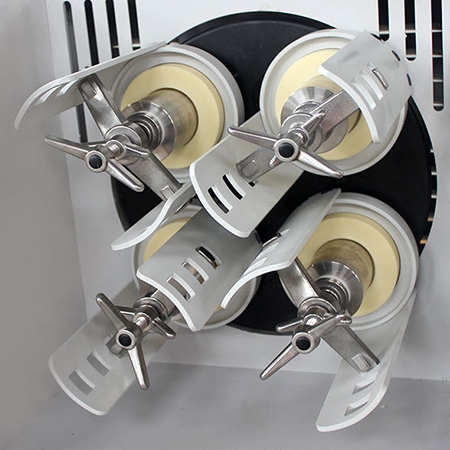
Horizontal Structure of Ball Milling Tank
- One of the primary advantages of the horizontal design in a ball mill is the enhancement of grinding efficiency. The result is a more vigorous and uniform collision between the grinding media and the materials, which leads to faster particle size reduction and a more efficient grinding process.
- The horizontal orientation facilitates better dispersion of materials and grinding media. In horizontal systems, the rotation minimizes sedimentation by maintaining a balanced and continuous movement of particles throughout the tank.
- The horizontal orientation allows for thorough mixing of the materials, ensuring that all regions of the tank experience effective impact and shear forces. This design feature leads to better utilization of the grinding media and enhances overall milling performance.
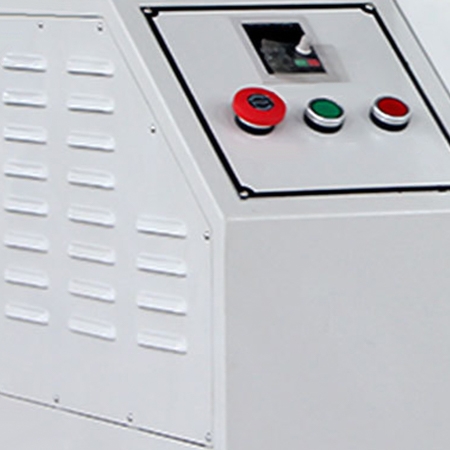
Horizontal Ball Mill Equipped With Cooling Vents
- Without proper heat management, this heat buildup can lead to temperature spikes that negatively impact both the ball mill grinding machine and the material. Cooling vents help prevent overheating.
- Cooling vents help maintain a lower and more consistent temperature within the milling jar, preserving the structural and chemical integrity of these sensitive materials.
- By incorporating cooling vents, the thermal load on these parts is reduced, leading to longer service life, reduced maintenance frequency.
Applications
SISCO ball mill is a versatile grinding device used in various industries for reducing materials into fine powders. In the mining industry, it is widely used to grind ores and minerals for metal extraction. In the cement industry, ball mills help grind clinker and other raw materials to produce cement. Overall, the ball mill machine is a critical piece of equipment for materials processing in industrial, laboratory, and manufacturing settings.
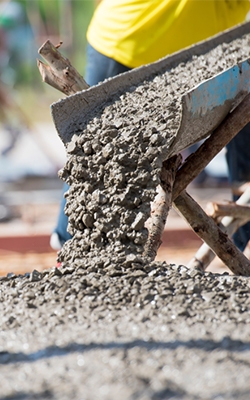
Cement Industry

Ceramic Industry

Mineral Processing
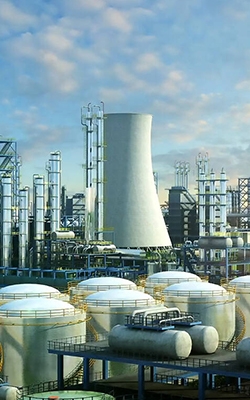
Chemical Industry
| Model | SISCO-BM-WXQM-0.4L | SISCO-BM-WXQM-1L | SISCO-BM-WXQM-2L |
| Capacity | 0.4L | 1L | 2L |
| Volume of Each Matched Pot | 50-100ml | 50-200ml | 50-500ml |
| Quanatity | 4 | 4 | 4 |
| Noise | 58±5db | 60±5db | 60±5db |
| Transmission Mode | Gear drive | ||
| Max Volume of Load | Two-thirds of pot's volume | ||
| Feed Size | Soil material ≤10mm; other material ≤3mm | ||
| Out-put Granularity | Minimum granularity can be reached to 0.1μm | ||
| Power Supply | 220V 50Hz/ 110V 60Hz | ||
| Motor Power | 0.75kW | ||
| Speed Control Mode | Frequency control | ||
| Total Run Time of Setting | 1-9999min | ||
| Reciprocal Running Time | 1-999min | ||
| Adjustable Speed | Revolution: 35-335rpm; Rotation: 70-670rpm | ||
| Dimension | 700*570*520mm | ||
| Net Weight | 86kg | ||
Structure:
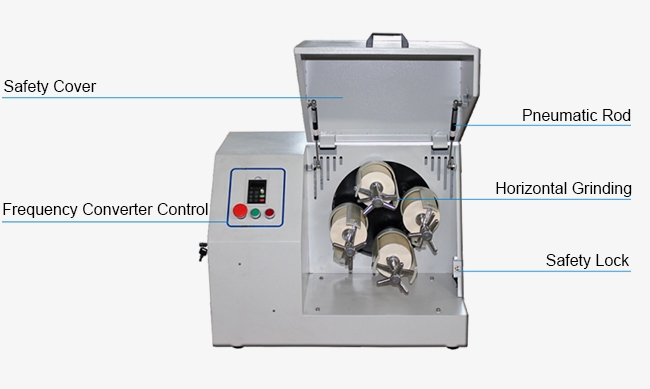
Q1: What is a ball mill?
A1: A ball mill is a type of grinding machine used to grind or blend materials into fine powder. It consists of a rotating cylindrical shell filled with steel or ceramic balls, which tumble and crush the material as the mill rotates. Ball mill machine is valued for their efficiency, simplicity, and ability to produce uniform particle sizes suitable for further processing or direct use in various products.
Q2: What are the types of ball mill?
A2: Ball mills are classified based on their operation and design. The main types include horizontal ball mills, vertical ball mills, roller ball mills, stirred ball mills and planetary ball mills, ideal for lab use. Others like batch ball mills process materials in set volumes, whereas continuous ball mills run uninterrupted for large-scale production. Selection depends on application, material properties, and desired particle size. Each type offers unique advantages for specific industrial needs.
Q3: What is a ball mill used for?
A3: A ball mill machine is widely used in various industries for grinding and blending materials. In mining, it grinds ores into fine powders for mineral extraction. In the cement industry, it processes raw materials and clinker. In laboratory, it is used for sample preparation and mechanical alloying. The ability to handle both wet and dry materials makes it versatile. Its effectiveness in producing uniform particle sizes makes ball mill crucial for both research and large-scale industrial applications.
Tips: How often does a horizontal planetary ball mill require maintenance?
A horizontal planetary ball mill typically requires routine maintenance every 200–300 hours of operation to ensure optimal performance and longevity. Regular checks should include inspecting the grinding jars, balls, and seals for wear or damage, and replacing them if necessary. If the ball mill machine is used for intensive or continuous operation, more frequent maintenance, weekly or even daily visual inspections, may be required to catch early signs of wear. Cleaning the ball mill machine after each use is essential to prevent contamination and buildup, especially when working with reactive or fine materials.
Thank you for buying industrial test and measurement equipment on SISCO.com, all products sold by SISCO and the partner cover a 12 months warranty, effective from the date of receiving the products.
What is covered?
SISCO is responsible for providing free spare parts, and free technical support to assist the customer to repair the defective products until the problem is solved.
What is not covered?
- Product purchased from anyone other than a SISCO store or a SISCO authorized reseller.
- Expendable parts.
- Routine cleaning or normal cosmetic and mechanical wear.
- Damage from misuse, abuse or neglect.
- Damage from use of parts other than SISCO approved.
- Damage from use outside the product’s usage or storage parameters.
- Damage from use of parts not sold by SISCO.
- Damage from modification or incorporation into other products.
- Damage from repair or replacement of warranted parts by a service provider other than a SISCO authorized service provider.
- Damage caused by the application environment not meeting the product usage requirements and the failure to perform preventive maintenance.

